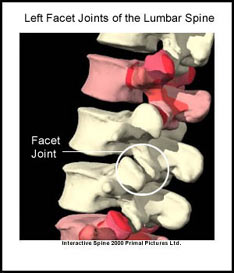In order to understand this topic it is important to understand the basic anatomy of the spine. Please review the section on basic spine anatomy before reading this section. To understand how the spine works, please review the section on the basic spine biomechanics.
What is facet joint syndrome?
Facet joint syndrome is the term used to describe low back pain that comes from the facet joints of the spine.
What are the facet joints of the back?
Facet joints are located at the posterior (back) aspect of the spine. Each back bone (vertebra) has four facet joints, an upper and a lower pair. These joints link the back of the spine together. They are designed to provide stability and control motion between the vertebrae. There is not a lot of movement at each individual facet joint, however, when all the facet joints are linked together they contribute to a significant amount of movement of the spine and allow complex movements such as bending backwards and rotation of the spine.

What does facet joint syndrome feel like?
These small joints are prone to injury, deterioration, and inflammation. Facet joint syndrome can occur anywhere in the spine including the low back. Pain arising from the facet joints is usually at the level of the affected facet joint(s), and is made worse by activities that put pressure on these joints i.e. leaning backwards and “extending” the lower back or twisting at the waist. Occasionally the pain may radiate to other areas such as the buttocks.
What causes facet joint syndrome?
There are a number of causes of facet joint syndrome. The facet joints may be irritated from trauma, repetitive movements, or arthritic changes. It is very common to develop degenerative changes in facet joints after trauma to the spine, as a result of an injury to the intervertebral disc or secondary to degenerative disc disease. If the intervertebral disc is damaged and the cushioning effect of the disc is lost, the facet joints at that level will undergo more stress, which may result in degeneration of the facet joint.
Poor posture can also cause undue stress on the facet joints. There is a natural inward curve in the lumbar (low back) section of the spine. In this position, the facet joints in the lumbar section are designed and positioned to handle a certain amount of stress. When the natural curve of the lumbar spine is exaggerated excess stress is placed on the facet joints. Poor body mechanics or how we use our body can also cause problems with the facet joints. Bending from the back, improper lifting, poor rest positions, and prolonged sitting in poorly designed chairs can all cause undo stress on the facet joints.
How is facet joint syndrome diagnosed?
In most cases, facet joint syndrome is diagnosed by a good medical history and a physical examination. X-rays of the lower back may help to rule out degenerative changes in the facet joints or degenerative disc disease. Depending on the severity of the problem, further tests such, as MRI and CT scans may also be required. Pain relief after an injection of local anaesthetic into the facet joints is a very accurate diagnostic tool for assessing facet joint irritation.
How is facet joint syndrome treated?
The majority of the time facet joint syndrome is treated without surgery. Treatment may involve hands-on physical therapy (joint mobilization or manipulation), exercise, and education on good spine posture, anti-inflammatory medications, pain medications and activity modification. In some cases these treatments may not be effective and other options such as joint injections (with a steroid) or procedures that block the pain messages from the nerves that surround the affected facet joints may be helpful. Rarely, surgery is required.
Most individuals with facet joint syndrome will recover and return to normal activities. Proper posture, proper body mechanics, and certain exercises should be maintained in order to ensure ongoing back health. Doctors and Physical Therapists that deal with people with facet joint syndrome can help outline an individualized treatment program.
What other information is available on facet joint syndrome?
Back Pain Info / Neck Pain Info’s links section has additional information on this topic. Links have been provided to other websites as well as online medical journals. Visit Joint Pain Info. Com for information on other joint injuries and problems.
